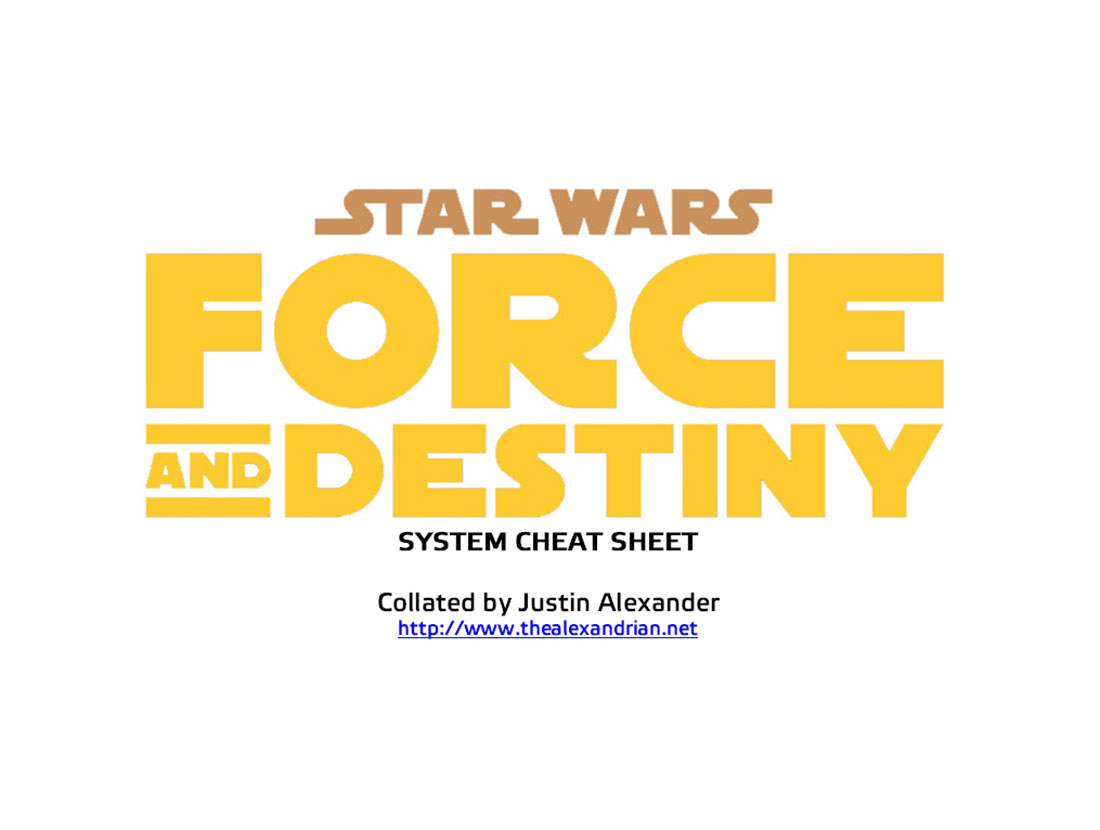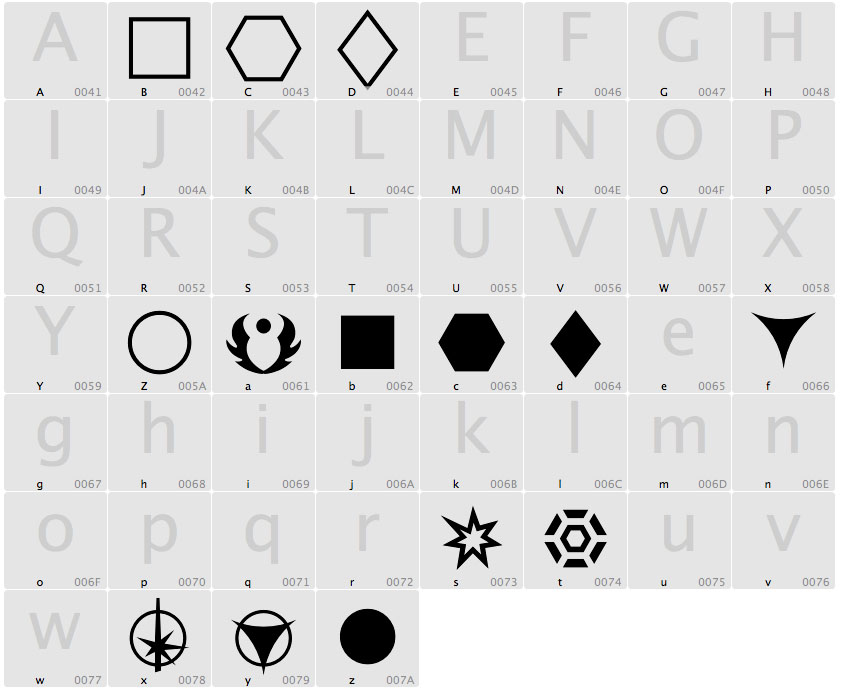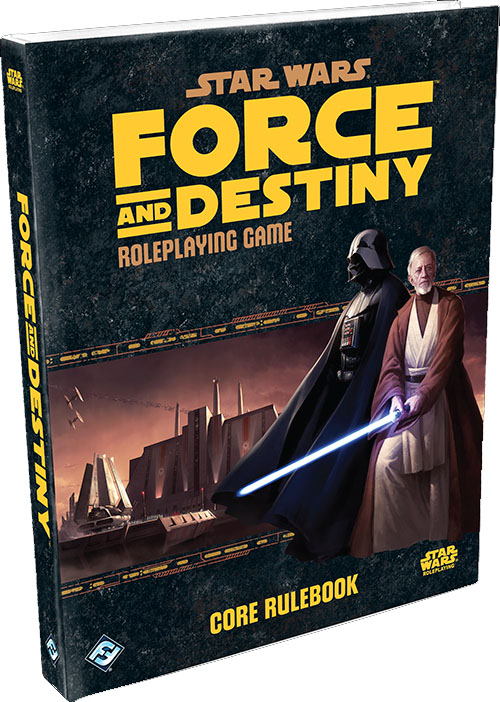I routinely prep these cheat sheets for RPGs that I run or play and share them here on the Alexandrian. But for those who haven’t seen them before: These summarize all the rules for the game — from basic action resolution to advanced combat mechanics. It’s a great way to get a grip on a new system and, of course, it also provides a valuable resource at the table for both the GM and the players. (For more information on the procedure I follow when prepping these cheat sheets, click here.)
This particular set of cheat sheets has been prepared for Fantasy Flight Games’ Star Wars: Force and Destiny roleplaying game. Force and Destiny is the third game in a trilogy of Star Wars games that FFG has produced — the others being Edge of Empire and Age of Rebellion. There are a few minor differences between the games, but they’re 99% identical and you should find that these cheat sheets prove valuable regardless of which system you’re running with only a few minor changes.
I’m a fairly lazy fellow, though, so I’m not going to be making those adjustments for the other games. In order to make it easier to customize these sheets if you’re playing one of the other games, I’m also making the original Microsoft Word document available:
Force and Destiny – System Cheat Sheet (Word)
You’ll also need these fonts:
(Without the fonts, the Word file is just going to look really, really weird.)
Over the next couple days I’ll also be posting a review of FFG’s Star Wars games and possibly a short scenario I designed for Force and Destiny.
HOW I USE THEM
I keep a copy of the system cheat sheet behind my GM screen for quick reference and I also provide copies for all of my players. Of course, I also keep at least one copy of the rulebook available, too. But my goal with the cheat sheets is to summarize all of the rules for the game. This consolidation of information eliminates book look-ups: Finding something in a half dozen or so pages is a much faster process than paging through hundreds of pages in the rulebook.
The organization of information onto each page of the cheat sheet is designed to be fairly intuitive. The actual sequencing of the pages is mostly arbitrary (although topics are obviously grouped together if they require multiple pages):
PAGE 1: Fantasy Flight’s Star Wars RPGs use a lot of symbols. A lot of symbols. So those are all summarize here, along with the basic difficulty tables, and the core check mechanics. Heart of the system, basically. New players will need to know all of this.
PAGE 2: The core of the combat mechanics. New players will need the left column and the right column. For the maneuvers listed in the middle column, you’ll also need to discuss Move. I also recommend discussing Aim and Taking Cover (without which, PCs are going to have a really rough time of it in combat).
PAGE 3: Advanced combat options and the Recovery rules. You’ll want to include a brief coverage of the Medicine skill in your initial system briefing. (Players always want to know how they can get their hit points back.)
PAGE 4: This page has all of the effects you can purchase using advantage, triumph, threat, and despair for both personal combat and vehicle combat. This is an oft-referenced page and you’ll probably find yourself using it more than anything else in the cheat sheets.
PAGE 5: All the disparate Force mechanics brought together in one place. This can be thought of largely as the Force and Destiny specific page. It’s the one you’ll want to swap out if you’re playing one of the other games (or supplement if you’re combining all of them together).
PAGE 6: Equipment & Environment. ‘Nuff said.
PAGES 7-8: All of the rules for Vehicle Combat. Took a lot of experimentation to figure out how to organize this information so that (a) it would all fit on two pages and (b) players could instinctively know where to look for something without a lot of practice. (For the most part, players can mostly focus on the first page, while the GM will need to more frequently reference the second. The exception are the damage and repair rules.)
PAGES 9-10: Critical Injury and Vehicle Critical Hit tables. Also ’nuff said.
PAGE 11: Skill Guide. This collects all of the guidelines given for using skills and resolving skill checks (except for skill uses that are summarized elsewhere in the cheat sheet, like using Medicine to treat injuries). Incredibly useful when adjudicating actions.
PAGE 12: Item Qualities & Skill List. Kind of a final catch-all. I kept trying to get the Skill List onto the first couple of pages, but it just wouldn’t fit. No system cheat sheet would be complete without a complete skill list, though: When I’m running a system for the first time, the biggest struggle is figuring out what the skills are so that I can call for the right skill checks. Much easier to just take ’em all in at a glance.
MAKING A GM SCREEN
These cheat sheets can also be used in conjunction with a modular, landscape-oriented GM screen (like the ones you can buy here or here).
Personally, I use a four-panel screen and use reverse-duplex printing in order to create sheets that I can tape together and “flip up” to reveal additional information behind them.
- Panel 1: Basic Mechanics (with Skill Guide and Skill List behind it)
- Panel 2: Combat (with Combat Options/Recovery and Attack Effects behind it)
- Panel 3: The Force (with Starships and Vehicles and Vehicle Combat Checks behind it)
- Panel 4: Equipment & Environment (with Critical Injuries and Critical Hits behind it)
Your mileage may vary here. I’ve also experimented with:
- Panel 3: Starships and Vehicles (with Vehicle Combat Checks and Equipment/Environment behind it)
- Panel 4: The Force (with Critical Injuries and Critical Hits behind it)
FFG STAR WARS – FURTHER READING
Review of Force and Destiny
Force and Destiny: System Cheat Sheet
FFG Star Wars: The Big Fix
Star Wars: Red Peace
















Hi!
This is a really great sheet– I’ve been playing EotE for a while and I’ve yet to find such a comprehensive and well-designed rules summary. That being said, I think I spotted a few errors when I skimmed through it. I’m afraid I only have my Beta F&D with me so I can’t give you accurate page numbers, but I’ll do my best to reference the text as precisely as possible.
1. Combat Check: As per “Making Ranged Attacks at Engaged Targets,” upgrade the difficulty of ranged attacks that are made against enemies that are engaged with an ally.
2. Unarmed Combat: The base damage is the attacker’s Brawn characteristic, not the Brawl skill.
3. Fear: The reputation of the scary thing (eg, Darth Vader) should upgrade Difficulty dice to Challenge dice, not add more difficulty dice.
4. Adversaries: Only minions after the first in the group upgrade skill checks– the first minion provides the base characteristic and nothing more.
5. Falling Damage: Characters apply soak to Wounds from falling damage, but not to Strain.
I haven’t had a chance to look over every part, but those issues are ones that I’ve had to look up a few times so they’ve stuck with me. If I have a chance, I might go over the sheet again to see if I can spot anything else.
Some more nitpicky ones:
I would also say that Minions and Rivals “suffer Strain as Wounds” rather than “Do not suffer strain.” I find FFG’s wording a little misleading.
It’s technically possible to have a characteristic at 7, if you apply a Cybernetic Enhancement to it. It’s under the Cybernetic Enhancement section.
Brawl checks can apply damage as Strain instead of Wounds.
Mounting an untrained animal is an Average Survival check. Not sure if you intentionally left the skill off of it.
Prone characters suffer a setback when making a melee attack, but not when making a ranged attack.
Heavy or Light gravity does not affect Resilience checks; ie, not all Brawn checks
Evasive Action should be called Evasive Maneuvers, and it should upgrade attacks from the ship, not increase difficulty.
Damage Control can be used as many times as the characters want to reduce System Strain, but can only be used once per encounter to repair Hull Trauma.
This cheat sheet helped my group and I immensely, as we are just getting started with the game. Thanks a lot!
I can’t get this to print correctly. Can you help me out? When I print all it shows is the dice symbols and no words. Any ideas? I downloaded the font and installed it I think.
Hmm, seems it’s just my color printer that won’t print the words. My b&w printed everything fine. I’m not super printer savvy, so any help would be appreciated.
Huh. I would have thought the opposite would be true (the dice symbol font not reaching your printer for some reason). You might try this: https://helpx.adobe.com/acrobat/kb/quick-fix-print-pdf-image.html
RE pg 2. There’s another type of check called a Combined Check. It’s primarily used to two-weapon fighting but I’ve found it useful for times when two different skills might apply to whatever the character is trying to do. Like when Rey is climbing that wall but also trying to not be spotted (a combined check of Athletics + Stealth).
I just noticed – under ‘Dice Pools’, upgrading dice, upgrading Difficulty Dice to Challenge Dice, when you have no Difficulty Dice Left, you should add a Difficulty Dice and not a Challenge Dice?
How do I found out what soak number I put on Star Wars Force and Destiny Character sheet?. Also, I wonder what conflict number I put down on The Star Wars Force and Destiny Character Sheet?.